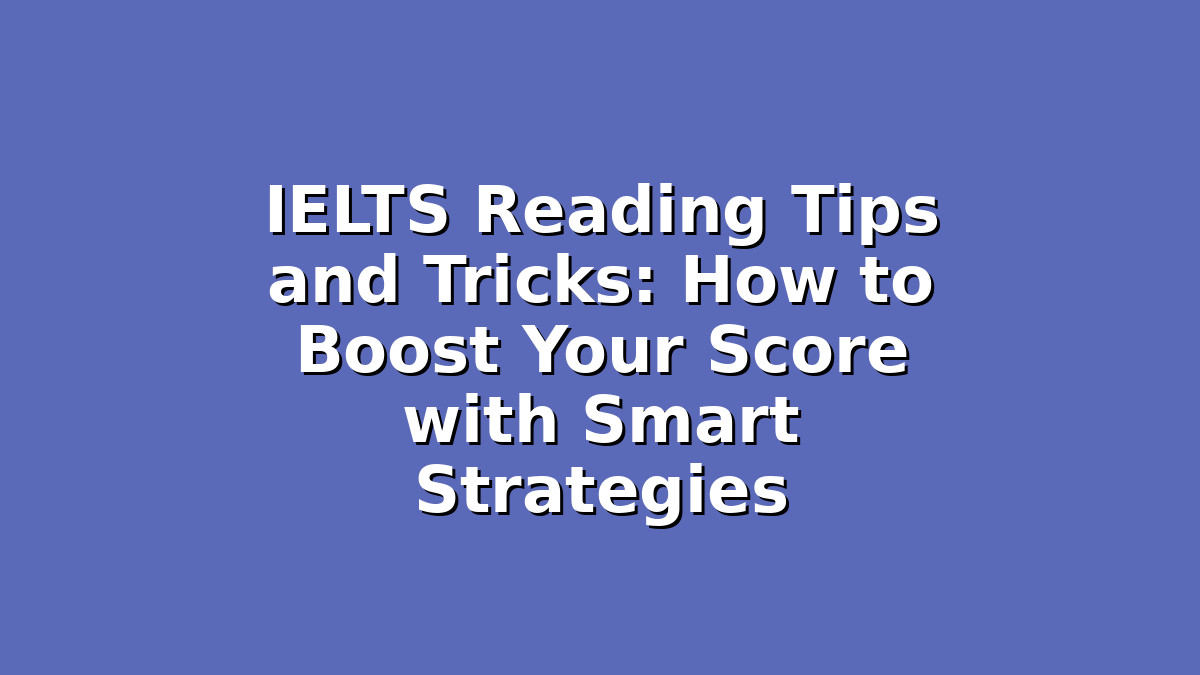Preparing for the IELTS Reading section can sometimes feel overwhelming, especially when you’re aiming for a high band score. But with the right approach, effective strategies, and consistent practice, you can confidently tackle this part of the exam. Whether you’re a student preparing for university admission, job requirements, or immigration purposes, mastering the IELTS Reading test is crucial. In this article, we’ll explore essential tips and tricks tailored for students to help you improve your reading skills and maximize your score.
Understanding the IELTS Reading Test Format
Before diving into the tips, it’s vital to understand the test structure. The IELTS Reading section consists of 40 questions designed to assess a wide range of reading skills, including reading for gist, main ideas, detail, logical argument, recognizing writers’ opinions, attitudes, and purpose.
– Academic Module: Contains three long reading passages taken from books, journals, magazines, and newspapers.
– General Training Module: Includes extracts from books, magazines, newspapers, notices, advertisements, company handbooks, and guidelines.
You have 60 minutes to answer all questions, so time management is key.
—
Section 1: Build Strong Reading Habits and Vocabulary
One of the most critical steps in preparing for the IELTS Reading test is cultivating effective reading habits and expanding your vocabulary.
1. Read Widely and Regularly
Try to read a variety of English texts every day, including newspapers, academic journals, blogs, and fiction. This will help you get used to different writing styles, tones, and vocabulary. Also, reading materials related to common IELTS topics (education, environment, technology, health, culture) can give you an edge.
2. Keep a Vocabulary Journal
As you encounter new words or phrases, write them down along with their meanings and example sentences. Regularly review this journal to reinforce your understanding. Learning synonyms and paraphrases is especially useful because IELTS tests your ability to recognize the same idea presented in different ways.
3. Practice Skimming and Scanning
Skimming is reading quickly to get the general idea of the text, while scanning means searching for specific information like dates, names, or numbers. Practicing these skills improves your reading speed and efficiency, which is crucial since you have just 60 minutes for 40 questions.
—
Section 2: Master Question Types and Strategies
The IELTS Reading section contains various question types, and each requires a slightly different approach. Familiarizing yourself with these types and learning smart strategies can save you valuable time.
1. Multiple Choice Questions
Read the question carefully and underline keywords. Predict the answer before looking at the options. Eliminate clearly wrong choices to narrow down your options.
2. True/False/Not Given or Yes/No/Not Given
Distinguishing between “False” and “Not Given” can be tricky. “False” means the statement contradicts the text, while “Not Given” means there isn’t enough information to decide. Always refer back to the passage to confirm before answering.
3. Matching Headings and Information
For matching headings, skim paragraphs to spot the main idea. For matching information, locate keywords in the question and scan the text to find where the information appears.
4. Sentence Completion and Summary Completion
Carefully read the instructions regarding the number of words you can use. Pay attention to collocations or fixed phrases in the text to help you complete sentences accurately.
5. Diagram Labeling and Flowchart Completion
Understand the process or structure first before filling in labels. Look for verbs and nouns in the text that match the blanks.
—
Section 3: Time Management and Practice Techniques
Time is one of the biggest challenges in the IELTS Reading section. Here’s how to improve your timing and practice effectively.
1. Allocate Time Wisely
Aim to spend about 20 minutes per passage. If you get stuck on a question, move on and come back to it later. This prevents you from wasting time and missing easier questions.
2. Use Practice Tests
Simulate exam conditions by timing yourself during practice tests. This builds stamina and helps you get familiar with the test format. Analyze your mistakes to understand where you’re losing marks.
3. Improve Reading Speed Without Losing Comprehension
Try speed reading exercises that focus on recognizing key information quickly. Avoid subvocalization (reading aloud in your head), which slows you down.
4. Focus on Keywords and Synonyms
IELTS often paraphrases information in the questions and text. Train yourself to identify synonyms and related terms quickly. This skill reduces confusion and helps you answer faster.
5. Stay Calm and Positive
Stress can slow you down and cause careless mistakes. Practice mindfulness or deep breathing before and during the exam to maintain focus and calmness.
—
Conclusion
Success in the IELTS Reading section is achievable with the right mindset and preparation. By building strong reading habits, mastering question types, and managing your time effectively, you can significantly improve your reading score. Remember, regular practice is key. Don’t get discouraged by difficult passages or questions; instead, view them as opportunities to grow your skills. Stay motivated, keep practicing, and you’ll be ready to ace the IELTS Reading test!
Good luck with your IELTS preparation journey—you’ve got this!

Responses